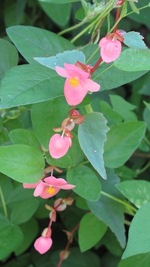 Seven species of moth unknown to science. New range extensions—by 100 miles—for two species of amphibian. Nine reptile records in the first herpetology survey of the Bacadéhuachi Mountains. The interim official report on the MABA expedition to El Rincón de Guadalupe (available as a PDF download) confirmed our initial high expectations for this beautiful and biologically unexplored region (to read the story of the first expedition, click here: Treasures of the Sierra Madre )
Seven species of moth unknown to science. New range extensions—by 100 miles—for two species of amphibian. Nine reptile records in the first herpetology survey of the Bacadéhuachi Mountains. The interim official report on the MABA expedition to El Rincón de Guadalupe (available as a PDF download) confirmed our initial high expectations for this beautiful and biologically unexplored region (to read the story of the first expedition, click here: Treasures of the Sierra Madre )
Despite our brief time there, it was clear that the area holds all the potential as an important biological sanctuary that the organizers of the trip expected. That potential prompted Tom van Devender, the director of the MABA program, to break with the usual MABA protocol and organize a return trip to the same spot. We jumped at the chance to be included, since we wanted to donate and install a couple of long-term motion-triggered trail cameras to expand our records of the large mammals in the area.
In contrast with the 40-plus participants on the first journey, we had just five companions this time: Tom van Devender and his ethnobotanist wife, Ana Lilia, entomologist John Palting (vampire-like in his ability to stay awake all night), herpetologist and virtuoso field-violinist Robert Villa, and retired biologist David Bygott (retired as in no longer salaried; biologists never really retire).
Roseann brought her terabyte-level memory for plants and an eagle eye for tracks. My job as a card-carrying “naturalist” was as usual to suck information from the people who really know their stuff, coalescing it into a dilettante catalog of superficial expertise. And to pull the odd oak tree out of the road.
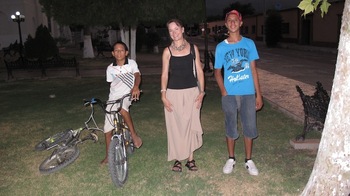 We took the same leisurely two days to reach el Rincón this time, stopping for a night in the hotel in Granadas. On the way through town Roseann and I asked about buying machaca (dried beef) at a little tienda, and were directed to another store. Actually we were led there by a boy on a bicycle, who rode ahead of the Land Cruiser popping frequent wheelies. Juan Carlos later joined us on a stroll around the town, jealously defending his position as our official guide by strategically placing his bike between us and other kids drawn, like moths to John Palting’s UV lamp, toward the novel sight of gringo tourists on foot.
We took the same leisurely two days to reach el Rincón this time, stopping for a night in the hotel in Granadas. On the way through town Roseann and I asked about buying machaca (dried beef) at a little tienda, and were directed to another store. Actually we were led there by a boy on a bicycle, who rode ahead of the Land Cruiser popping frequent wheelies. Juan Carlos later joined us on a stroll around the town, jealously defending his position as our official guide by strategically placing his bike between us and other kids drawn, like moths to John Palting’s UV lamp, toward the novel sight of gringo tourists on foot.
Next morning, the high section of road to the site revealed a massive fallen dead oak blocking the way. A HumVee full of Mexican Army troops that passed us earlier had already driven through the brush around it, but we wanted to avoid the degradation that follows when such deviations become permanent, so we hooked up the Land Cruiser and tugged it out of the way.
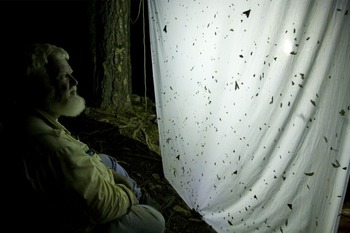 Tom VanDevender contemplating the incredible biodiversity of Bacadéhuachi.Once installed in el Rincón’s adobe buildings (Roseann and I spurned our tent for a penthouse suite in the second-floor library/museum), near entomological disaster occurred. The lodge’s generator was burned out, and for the first time since he bought it John’s polite little Honda generator, which powers his insect lights, refused to start. No 120VAC = no insects. But in stepped David Bygott, an old hand at bush mechanicking from many years in Africa, and got it running again with a simple spark plug cleaning.
Tom VanDevender contemplating the incredible biodiversity of Bacadéhuachi.Once installed in el Rincón’s adobe buildings (Roseann and I spurned our tent for a penthouse suite in the second-floor library/museum), near entomological disaster occurred. The lodge’s generator was burned out, and for the first time since he bought it John’s polite little Honda generator, which powers his insect lights, refused to start. No 120VAC = no insects. But in stepped David Bygott, an old hand at bush mechanicking from many years in Africa, and got it running again with a simple spark plug cleaning.
Our half-platoon-size group didn’t qualify for the CONANP crew who cared and cooked for us last trip, but no matter. The first night Roseann made up a huge pot of cazuela con machaca; the second night John used the leftover as a base to produce an equally huge pot of albondigas. And David had brought and generously shared a stash of coffee from a farm he knew high on the slopes of Ngorongoro crater in Tanzania. Subsistence-wise, we were stylin’.
The protein and caffeine stood us in good stead the next day. Robert, Roseann, and I packed up the two trail cameras donated by ConserVentures (we opted for the 8 megapixel Bushnell Trophy Cam, with metal bear-proof housing and locks) and headed east along a ridge trail that soon trailed off into not much of a trail, then into nothing but brush.
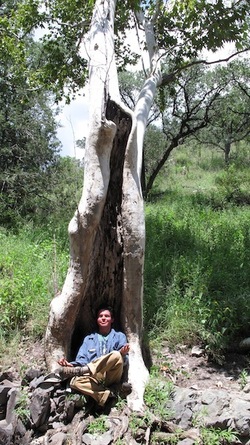 Robert Villa doing a little meditation in God's own zen garden.At a ridge overlooking what appeared to be a nice funnel in the watershed below us, we bushwhacked downslope to the stream, which tumbled through God’s own zen garden of rock pools and overhanging sycamores.
Robert Villa doing a little meditation in God's own zen garden.At a ridge overlooking what appeared to be a nice funnel in the watershed below us, we bushwhacked downslope to the stream, which tumbled through God’s own zen garden of rock pools and overhanging sycamores.
We secured the camera to a tree overlooking a likely trail, and gave it an impromptu, only slightly irreverent blessing acknowledging the church’s guardianship here:
“In the name of the jaguar, the ocelot, and the jaguarundi: Let it be said. Let it be heard. Let it come to pass [by our cameras.]”
In truth, given the sublime surroundings, I wouldn’t be at all surprised if a perusal of the camera’s SD card in a few months reveals a bearded and robed elderly gentleman strolling through his creation for a quick visit.
We scrambled up the stream for a bit, then clambered back uphill to the trail and headed toward the lodge under a cloudy and distantly rumbling sky. Above the confluence where our first camera had had such good luck, I left Robert and Roseann to continue to camp and raced the storm to install our second camera in the same spot as the original, just across the stream.
(Robert had been collecting and pressing plant specimens for Tom along our hike. He’d run out of room in the press he’d brought, so had simply begun sticking cuttings in his hat and various other parts of his clothing. By the time we split up he was barely recognizable as human any more; he resembled a walking shrub comprising six or seven orders of the plant kingdom.)
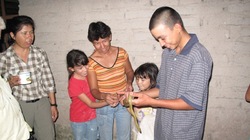 The caretaker's family was at first too frightened of the green rat snake to touch it, but Ana Lilia, a consumate teacher, explained its natural history and harmlessness, and soon everyone touched or held it.Fortunately I found no rain-flooded drainage to negotiate. I only caught a short brisk downpour that gave me an opportunity to try out my new silicone-coated Sea to Summit poncho. After decades of testing and thus always having available the latest in Gore-Tex foul-weather shells, I’ve become re-acquainted with how useful a simple poncho can be when you have not only yourself but a rucksack full of camera gear to cover.
The caretaker's family was at first too frightened of the green rat snake to touch it, but Ana Lilia, a consumate teacher, explained its natural history and harmlessness, and soon everyone touched or held it.Fortunately I found no rain-flooded drainage to negotiate. I only caught a short brisk downpour that gave me an opportunity to try out my new silicone-coated Sea to Summit poncho. After decades of testing and thus always having available the latest in Gore-Tex foul-weather shells, I’ve become re-acquainted with how useful a simple poncho can be when you have not only yourself but a rucksack full of camera gear to cover.
On our last morning I pulled off a bit of a coup when I caught a beautiful little mountain kingsnake (Lampropeltis pyromelana), not unexpected but a first record for the site. I discovered it after 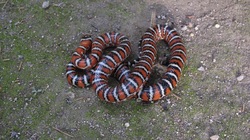 Mountain kingsnakea grueling pre-dawn search through forest debris among precariously balanced house-sized boulders.
Mountain kingsnakea grueling pre-dawn search through forest debris among precariously balanced house-sized boulders.
Actually not. I discovered it when, on my way up the stone steps to the kitchen for some of David’s Tanzanian coffee, I glanced down to see the snake slithering nonchalantly down the same steps. All I had to do was reach down and pick it up. Some coups are easier than others.
Roseann and I left a day ahead of our companions due to a commitment in Tucson (our main goal had been to install the trail cameras), but we stopped in Bacadéhuachi to follow the cryptic directions—“down this road from the plaza, left on that one, go past a school yard, look for a yellow house”—to stock up on the local bacanora, of which we’d had just a taste last trip. This time around we bought two full liters, amusingly decanted for us from a backyard barrel into a pair of presumably well-rinsed Bud Light bottles. Contents further from the original could hardly be imagined.
Epilogue:
This time we found the Museo del Indio Geronimo in Fronteras open, presided over only by a trio of youths who showed up after we had strolled in and begun looking around. There were several historic photos of 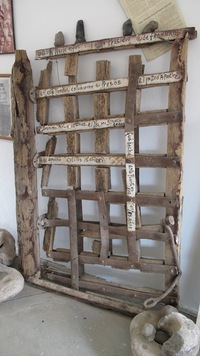 The jail door that purportedly held Geronimo in Fronteras.Geronimo and his band, an ancient wood and iron gate that had purportedly held them after they turned themselves in to the duplicitous General Miles in 1886, and, well, that was about it as far as Geronimo memorabilia was concerned. The rest was a farrago of interesting stuff centered more around the Mexican Revolution than the Apache resistance. The era represented continued up to an including an unexplained vintage telefax machine that must have weighed 300 pounds.
The jail door that purportedly held Geronimo in Fronteras.Geronimo and his band, an ancient wood and iron gate that had purportedly held them after they turned themselves in to the duplicitous General Miles in 1886, and, well, that was about it as far as Geronimo memorabilia was concerned. The rest was a farrago of interesting stuff centered more around the Mexican Revolution than the Apache resistance. The era represented continued up to an including an unexplained vintage telefax machine that must have weighed 300 pounds.
We thanked the young guardians of the place—there was no box for donations nor was one asked for—and continued north. An hour later we were across the border—fortunately minus the terminal embarrassment I would have experienced had anyone from Homeland Security found Bud Light bottles in a vehicle in which I also resided. “No, officer, it’s not beer, really. Have a taste . . .”
 - Writer, naturalist, & explorer Jonathan Hanson is co-founder and volunteer director of ConserVentures
- Writer, naturalist, & explorer Jonathan Hanson is co-founder and volunteer director of ConserVentures
